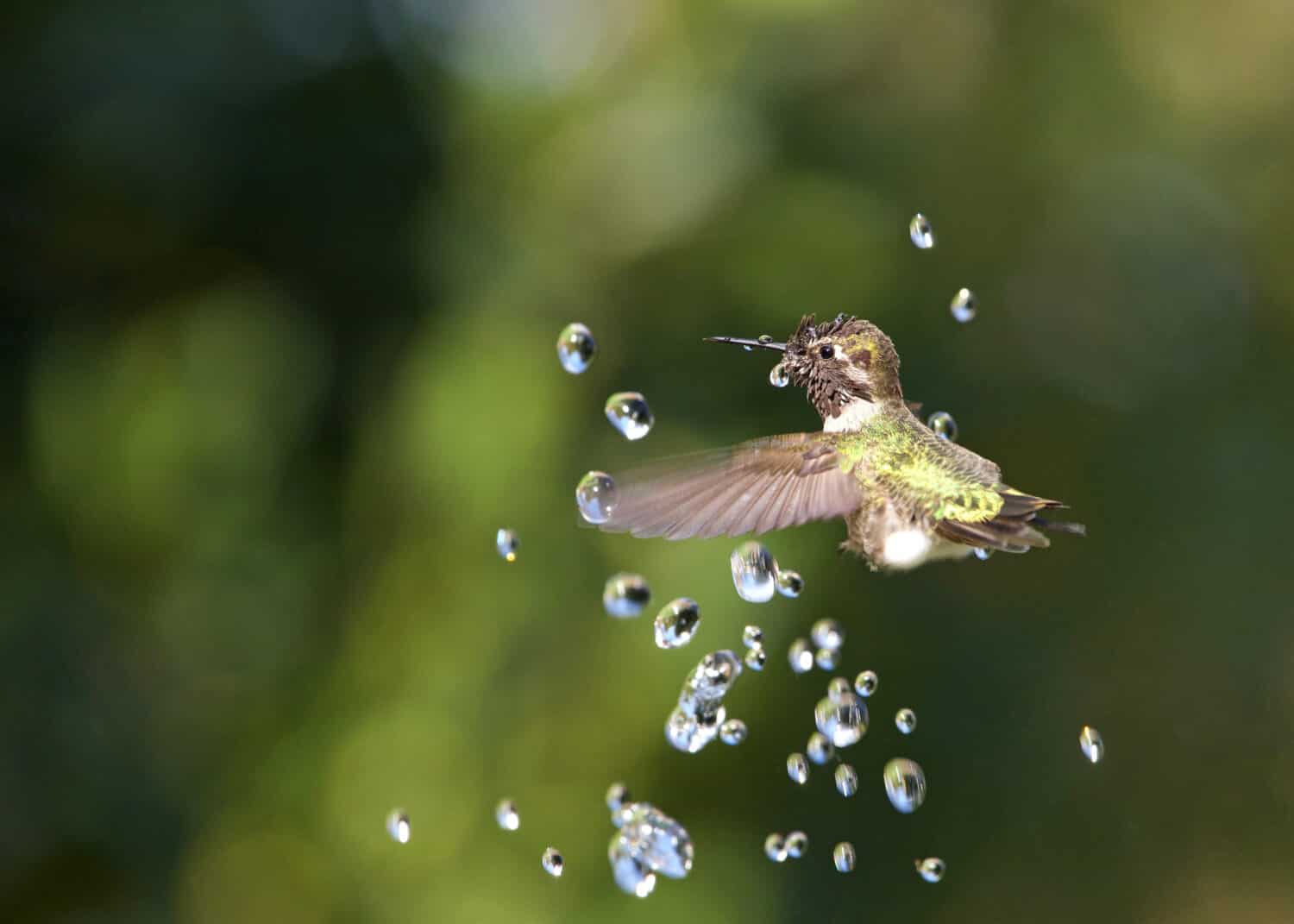One of the most recognizable backyard birds, hummingbirds delight birdwatchers everywhere with their bright feathers and aerial acrobatics. Hummingbirds live and migrate throughout the United States, with over 20 species frequently seen. Though few species live in a single place year-round, hummingbirds are known to return year after year to the same areas. They are a sure sign of spring, especially for those in northern climates.
As one of the most northern states, Idaho birdwatchers relish hummingbird sightings. The state’s harsh winters drive off most of the minute hummers, whose bodies can’t easily withstand the cold temperatures. Idaho Fish & Game reports five consistent species of hummingbird documented in the state. Let’s explore them!
Idaho’s Hummingbird Species
- Rufous hummingbird
- Calliope hummingbird
- Broad-tailed hummingbird
- Black-chinned hummingbird
- Anna’s hummingbird
Rufous Hummingbirds
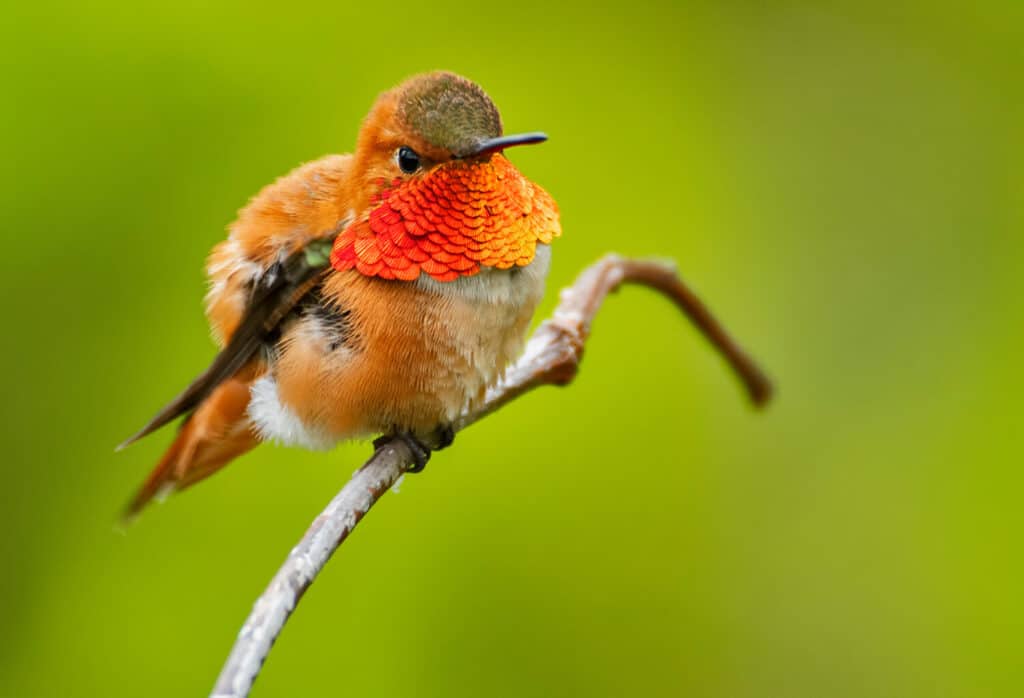
The orange and copper coloration of rufous hummingbirds makes them particularly eye-catching.
©punkbirdr/Shutterstock.com
Rufous hummingbirds stand out from other hummingbird species with their full body of red and orange feathers rather than the typical green or white body. Their fiery nature isn’t limited to just their feathers, either — rufous hummers are one of the most aggressive hummingbird species. These feisty fellows will chase other hummingbirds away from feeders and flowers alike. Rufous hummingbirds take a curious oval-shaped migration route and are most likely seen in Idaho in the mid-to-late summer as they return south. They travel north up the Pacific coast, nest as far north as Alaska, then follow the Rocky Mountains south for the winter.
Calliope Hummingbirds

Calliope hummingbirds exhibit stunning stripe-like gorgets.
©MTKhaled mahmud/Shutterstock.com
Most hummingbirds flash their bright, iridescent feathers in a solid patch under their chin and on their throat (called a gorget). Calliope hummers, on the other hand, exhibit their colors in long feathers that often look like stripes. Some birdwatchers even relate their gorget to the stripes on a peppermint candy! Calliope are some of the smallest hummingbirds and prefer to nest in the northern Rocky Mountains.
Broad-Tailed Hummingbirds

Broad-tailed hummingbirds carefully select their nesting site to protect their eggs from cold weather.
Another mountain-dweller, broad-tailed hummers are primarily seen across southern Idaho with nests at elevations as high as 10,500 feet. Broad-tailed hummingbirds can easily be mistaken for ruby-throated hummers — they have the same rosy patch on their throat — but ruby-throats prefer the East Coast, and broad-tails have an orange tint on their sides. Because they nest at higher elevations, broad-tailed hummingbirds add spiderwebs and gossamer to their nests as insulation to keep their eggs warm.
Black-Chinned Hummingbirds

Black-chinned hummingbirds can be found in Idaho’s valleys and lowlands.
©rck_953/Shutterstock.com
In a slight misnomer, black-chinned hummingbirds are known for their bright purple throat feathers. Black-chins prefer bugs to nectar and often catch their meals while in flight, demonstrating their incredible flight skills as they chase their meal. Unlike the other hummingbird species discussed above, you won’t find these hummingbirds in the mountains as they prefer lower elevations. In fact, black-chinned hummingbirds are the most common species seen in Idaho’s valleys and lowlands.
Anna’s Hummingbirds
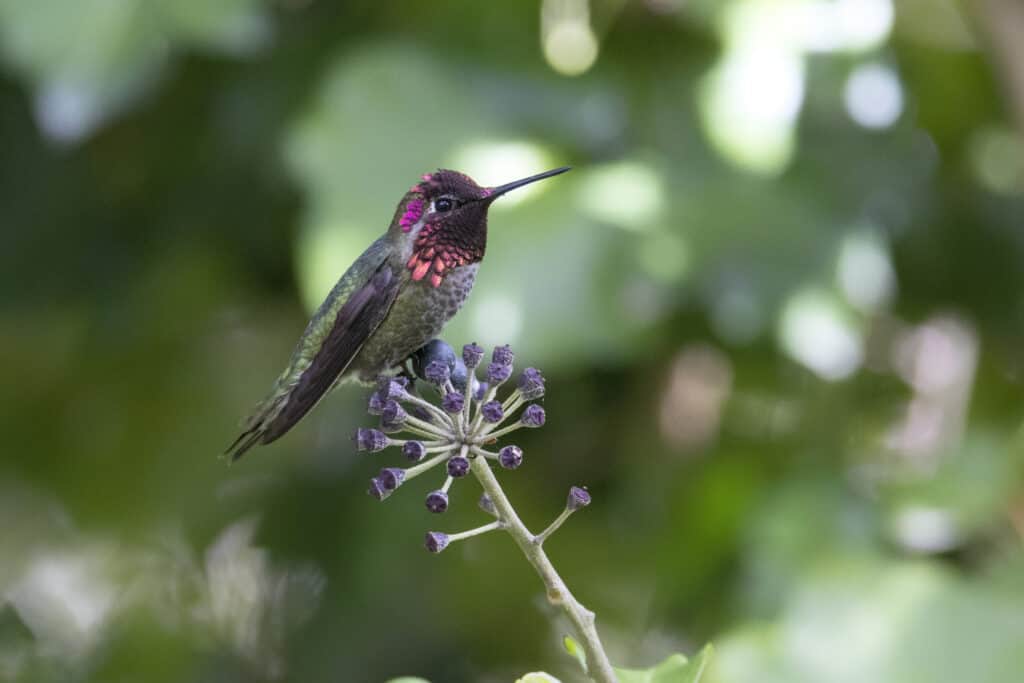
The bright feathers on the Anna’s hummingbird extend to the top of their head and throat.
©Devonyu /Shutterstock.com
These hummingbirds are unique in the world of hummers. Anna’s have evolved differently from their migratory counterparts and instead choose one area to live year-round, meaning their gorgeous ruby heads can be seen in Idaho all year! In addition, Anna’s hummingbirds are the only hummingbirds with a big enough brain to sing like other birds do — no other species of hummer can do that!
The evolution of Anna’s hummingbirds is fascinating and has occurred just in the last 100 years. In the early 1900s, Anna’s only nested along the border of California and Mexico. As more and more cities were built, though, it’s thought that the introduction of non-native plants and the popularity of hummingbird feeders allowed the hummers to expand their territory north and adapt to colder weather. The first Anna’s hummingbird seen in Idaho was recorded in 1976. Now, they’re seen throughout the Pacific coast and as far east as the Rocky Mountains.
Destination: Where Do Idaho’s Hummingbirds Go?
With the exception of the Anna’s hummingbird, Idaho’s hummers migrate each year. With average temperatures between 30 and 40 degrees — in the daytime! — Idaho’s winters are too harsh for most hummingbirds. Their tiny bodies and huge caloric needs require them to migrate where their food sources are plentiful. Most hummingbirds spend their winters in Mexico, Central America, and other similar tropical climates.
Come spring, the hummingbirds travel north. Many birdwatchers consider the hummingbird a herald of spring — they arrive just as flowers bloom and insect populations boom. In Idaho, look for black-chinned, broad-tailed, and calliope hummers in late April to early May as they continue their journey north or settle in for the season. Rufous hummingbirds will come through the state in the fall, as will any other hummers that spent their summer farther north. Experts at Idaho Fish & Game recommend you leave your feeder out through September for these migratory species — they’ll need the snack on their long journey!
Winter for Anna’s Hummingbirds
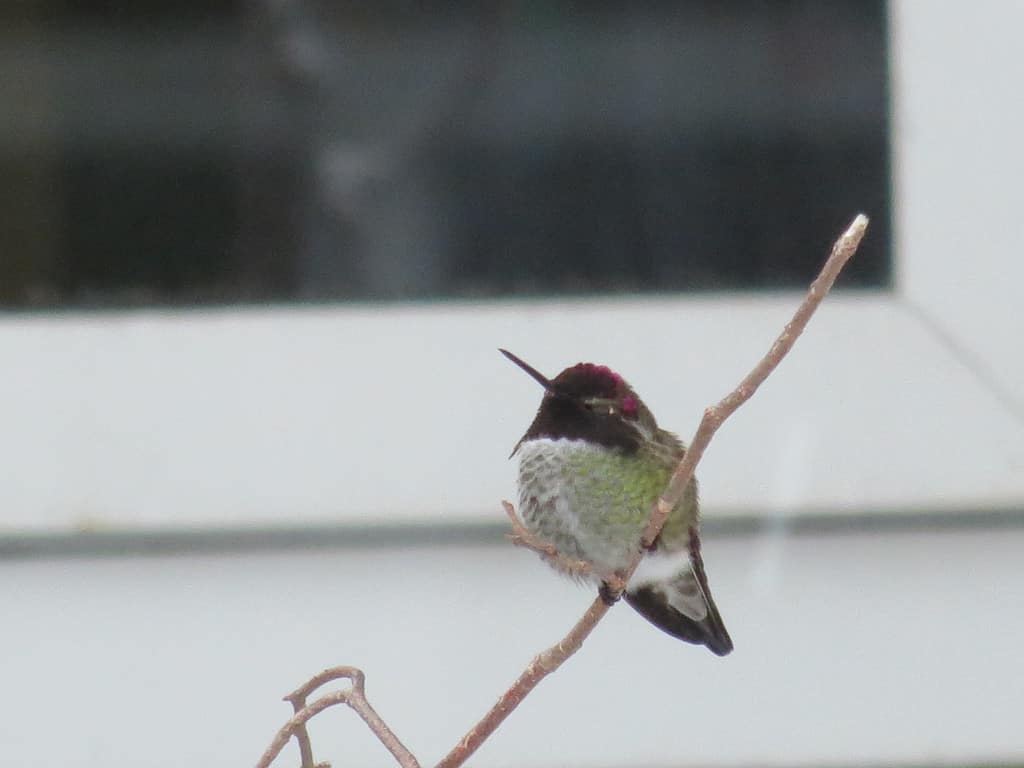
Anna’s hummingbirds must gain weight to survive the winter.
Regardless of their adaptations, Anna’s hummingbirds still have to be careful during winter. They start to gain weight as fall temperatures drop, converting their sugar-based diet into fat. This helps them withstand colder temperatures. In addition, for those really cold days and long, dark nights, Anna’s hummers enter a state called torpor. Almost like a quick hibernation, torpor lowers the hummingbird’s heart rate, metabolic rate, and body temperature. By drastically reducing the amount of energy their body needs, hummingbirds can hold off starvation until the next morning or when the weather warms up.
So if you notice the flash of their fuchsia feathers any time after October 1st, keep your feeders out. Easy access to food, like sugar water, will help them survive the winter. Plus, becoming a reliable food source will keep your resident hummers nearby for years to come!
Studying the Hummingbird
Idahoans love their hummingbirds. There are two initiatives currently studying their favorite feathered friends, tracking migration patterns, species, and size.
Boise State University’s Intermountain Bird Observatory has partnered with the Hummingbird Conservation Networks and the Western Hummingbird Partnership since 2012. Together, they monitor hummingbirds in the Boise National Forest and collect information on abundance, breeding conditions, and migratory timing. They specifically focus on black-chinned, rufous, and calliope hummingbirds and host banding events open to the public each summer.
Since 2003, Hummingbird Roundup has taken place at the Rudeen Ranch in southeast Idaho. Hummingbird Roundup began as a single-woman operation and has since grown into a yearly event that provides crucial data on lifespan, reproduction rates, hybridization, migration, and survival. In 2022, Hummingbird Roundup worked with 327 new and returning hummers — since Hummingbird Roundup began, they have banded nearly 8,000 hummingbirds! Fun fact, the oldest hummingbird captured by Hummingbird Roundup was an 11-year-old black-chinned male who returned multiple times over the years.
How To Attract Hummingbirds
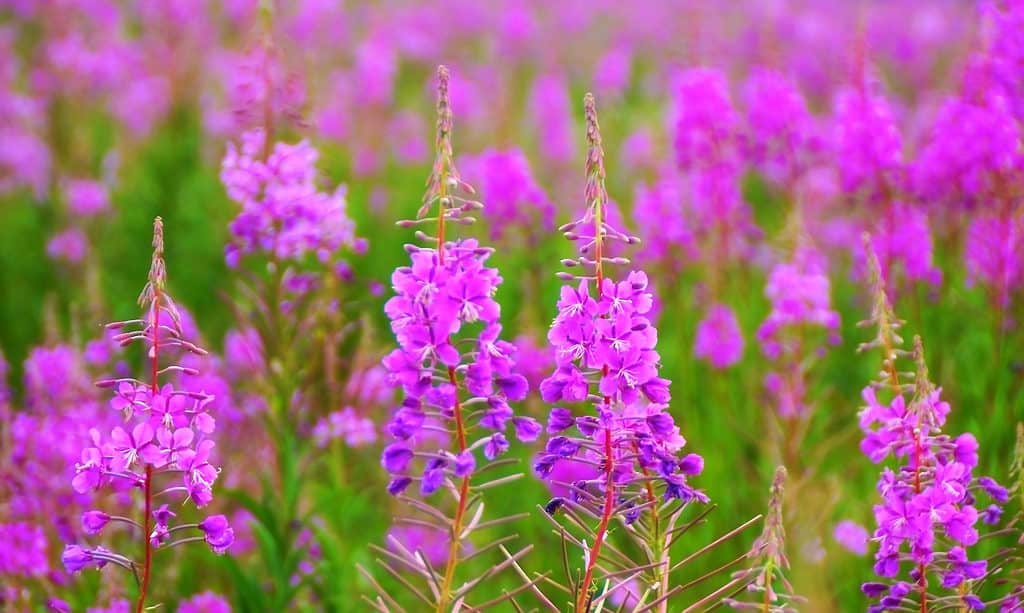
Fireweed is a great native plant for hummingbirds to enjoy.
©Real Moment/Shutterstock.com
Hummingbirds must eat almost constantly in order to fuel their lightning-fast wings and live on a diet of bugs and nectar. Though hanging feeders are a great way to attract hummers to your yard, natural nectar sources, like flowers, are even better if you’ve got the space. Hummingbirds especially love tube-shaped flowers — many of which evolved alongside the hummingbird to achieve their best pollination rates. Here are some plants native to Idaho sure to bring the hummers in droves.
- Indian paintbrush
- Columbine
- Sage
- Twinberry honeysuckle
- Fireweed
- Scarlet gilia
- Penstemon
Thank you for reading! Have some feedback for us? Contact the AZ Animals editorial team.

